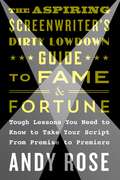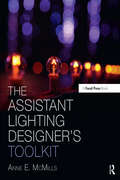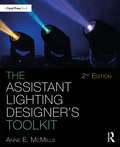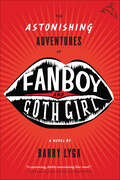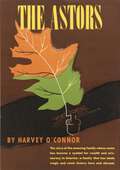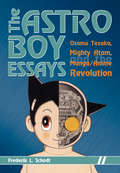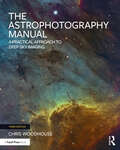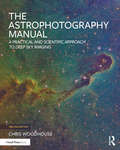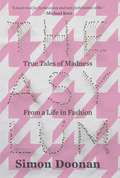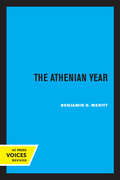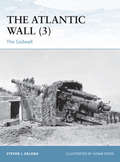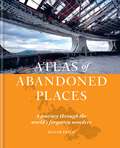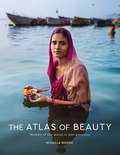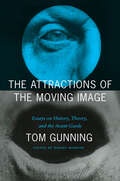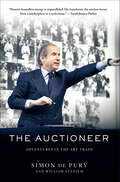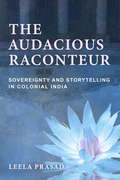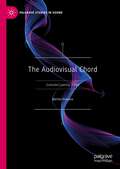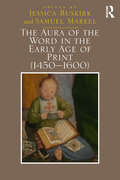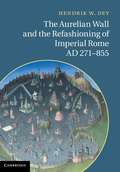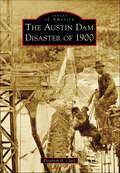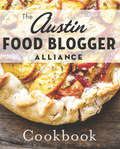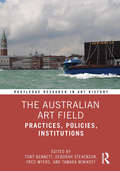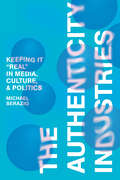- Table View
- List View
The Aspiring Screenwriter's Dirty Lowdown Guide to Fame and Fortune: Tough Lessons You Need to Know to Take Your Script from Premise to Premiere
by Andy RoseA humorous and pithy guide to the craft of writing a screenplay and the business of being a screenwriter.Seeing your name on the silver screen beneath the words "Written By" is a moment most writers only dream of. But for those daring and talented few, brave enough to take their hopes to Hollywood, there are clear and tangible steps to achieve that goal if one knows the path. The Aspiring Screenwriter's Dirty Lowdown Guide to Fame and Fortune provides that path. And Andy Rose has walked it.With years of experience with every major film studio and network, and dozens of successful screenplays, Andy knows the business. He’s here to debunk the big screen and teach you how to write a blockbuster screenplay and equally important, how to sell it.Andy has worked with the best: Ron Howard, Tom Hanks, David Geffen, and Jeff Katzenberg to name a few. He has filled this book with real life examples to learn from including contracts, screenplays, treatments, press, and more. For anyone who’s ever dreamed of writing a screenplay, for anyone who’s wondered how to sell one, this is a must read.
The Assistant Lighting Designer's Toolkit (The Focal Press Toolkit Series)
by Anne E. McMillsWhat are the do’s and don’ts of being a good assistant lighting designer? What are focus tapes, and how do I use them? What is the best method for creating a magic sheet? What should be found in every assistant’s kit? How do I make that first important leap into this professional career? Answer these questions and many more with The Assistant Lighting Designer’s Toolkit. This definitive guide unlocks the insider-secrets used to succeed as a professional assistant lighting designer (ALD) – whether choosing assisting as a career or while transitioning to another. This book outlines, step-by-step, the challenges the ALD faces during every phase of production. Never before has a resource existed that views the design process through the eyes of the assistant. Intermingled among the nuts and bolts of the paperwork and essential procedures, top industry professionals reveal tips for personal survival in this challenging career – both domestically and abroad as well as in other careers in lighting. Within these pages are the industry secrets rarely taught in school! The author's website can be found at http://www.aldtoolkit.com/.
The Assistant Lighting Designer's Toolkit (The Focal Press Toolkit Series)
by Anne E. McMillsThe ground-breaking text that took the lighting world by storm returns in its second edition, unlocking the insider secrets and proven, time-tested methods to succeed as a professional assistant lighting designer. This definitive guide outlines, step-by-step, the daily challenges that assistant lighting designers face during every phase of production, and the solutions for overcoming them. Furthermore, intermingled among the highly detailed paperwork techniques and essential procedures, top industry professionals reveal tips for success in this challenging career. This fully updated second edition features: All new advice, real-world stories, and current paperwork examples from over 120 working professionals. Updated industry practices with case studies from the professionals themselves, such as how to create a video network to record previews for the lighting department; how much printing is done in an increasingly paperless world; how to produce a set electrics package; and how the industry interfaces with cutting-edge technology like remote followspots and pre-visualization software. New lifestyle tips for traveling abroad, negotiating contracts, and dealing with stressful situations. The Assistant Lighting Designer's Toolkit, the most trusted authority on assisting in the lighting world, equips budding assistant lighting designers and students studying lighting design with the insider knowledge they need to achieve the successful career that they have always wanted—whether choosing assisting as a career or as a stepping-stone toward design. Within these pages are the industry secrets rarely taught in school!
The Astonishing Adventures of Fanboy and Goth Girl: A Novel
by Barry LygaFanboy has never had it good, but lately his sophomore year is turning out to be its own special hell. The bullies have made him their favorite target, his best (and only) friend seems headed for the dark side (sports and popularity), and his pregnant mother and the step-fascist are eagerly awaiting the birth of the alien life form known as Fanboy's new little brother or sister. Fanboy, though, has a secret: a graphic novel he's been working on without telling anyone, a graphic novel that he is convinced will lead to publication, fame, and--most important of all--a way out of the crappy little town he lives in and all the people that make it hell for him. When Fanboy meets Kyra, a.k.a. Goth Girl, he finds an outrageous, cynical girl who shares his love of comics as well as his hatred for jocks and bullies. Fanboy can't resist someone who actually seems to understand him, and soon he finds himself willing to heed her advice--to ignore or crush anyone who stands in his way.
The Astors
by Harvey O'ConnorThe Astors is a comprehensive biography of one of the most prominent and influential families in American history. The Astors were a wealthy and powerful family who made their fortune in the fur trade and real estate, and went on to become one of the most influential families in New York City and beyond. This book traces the history of the Astor family from its humble beginnings in Germany to its rise to prominence in America and explores the lives of some of its most famous members, including John Jacob Astor, William Waldorf Astor, and Brooke Astor. It delves into their personal lives, business ventures, and philanthropic endeavors, and sheds light on the family's role in shaping the cultural and economic landscape of America. Harvey O’Connor’s meticulously researched and engagingly written book, which includes numerous family photos and a thorough genealogy, offers a fascinating glimpse into the lives of one of America's most iconic families. It is a must-read for anyone interested in American history, business, and culture.Also available in audiobook format.
The Astro Boy Essays
by Frederik L. SchodtThe pioneering genius of Japan's "God of Comics," Osamu Tezuka (1928-89), is examined through his life's masterwork: Tetsuwan Atomu, also known as Mighty Atom or Astro Boy, a comic series featuring a cute little android who yearns to be more human. The history of Tetsuwan Atomu and Tezuka's role in it is a road map to understanding the development of new media in Japan and the United States. Topics include Tezuka's life, the art of animation, the connection between fantasy robots and technology, spin-offs, and Astro Boy's cultural impact.Frederik L. Schodt is a translator and author of numerous books about Japan, including Manga! Manga! and Dreamland Japan. He often served as Osamu Tezuka's English interpreter. In 2009 he was received the The Order of the Rising Sun, Gold Rays with Rosette for his contribution to the introduction and promotion of Japanese contemporary popular culture.
The Astronaut Who Painted the Moon: The True Story Of Alan Bean
by Dean RobbinsJourney to the moon on the Apollo 12 mission with Alan Bean, the fourth astronaut to walk on the lunar surface and the only artist to paint its beauty firsthand!As a boy, Alan wanted to fly planes. As a young navy pilot, Alan wished he could paint the view from the cockpit. So he took an art class to learn patterns and forms. But no class could prepare him for the beauty of the lunar surface some 240,000 miles from Earth. In 1969, Alan became the fourth man and first artist on the moon. He took dozens of pictures, but none compared to what he saw through his artistic eyes. When he returned to Earth, he began to paint what he saw. Alan's paintings allowed humanity to experience what it truly felt like to walk on the moon. Journalist and storyteller Dean Robbins's tale of this extraordinary astronaut is masterful, and artist Sean Rubin's illustrations are whimsical and unexpected. With back matter that includes photos of the NASA mission, images of Alan's paintings, and a timeline of lunar space travel, this is one adventure readers won't want to miss!
The Astrophotography Manual: A Practical Approach to Deep Sky Imaging
by Chris WoodhouseThe Astrophotography Manual's Third Edition is the most up to date and authoritative guide for enthusiasts who want to create beautiful images of nebulas, galaxies, clusters, and the stars with the latest professional tools and techniques. The book has been completely revised and, after a brief astronomy primer, it guides readers through the full astrophotography process, from choosing and using equipment to image capture, calibration, and processing. An extensive Assignment section at the end shows how several deep sky objects were captured and processed. Throughout the book, the Author’s combination of technical background and hands-on approach brings the science down to earth, with practical methods to ensure success. This latest edition is packed full of fresh images and ideas, using the latest hardware and software tools. Given its breadth, depth, and online resources, this book is ideal for those who wish to take their astrophotography to the next level.
The Astrophotography Manual: A Practical and Scientific Approach to Deep Sky Imaging
by Chris WoodhouseThe Astrophotography Manual, Second Edition is for photographers ready to move beyond standard SLR cameras and editing software to create beautiful images of nebulas, galaxies, clusters, and the stars. Beginning with a brief astronomy primer, this book takes readers through the full astrophotography process, from choosing and using equipment to image capture, calibration, and processing. This combination of technical background and hands-on approach brings the science down to earth, with practical methods to ensure success. This second edition now includes: Over 170 pages of new content within 22 new chapters, with 600 full-color illustrations. Covers a wide range of hardware, including mobile devices, remote control and new technologies. Further insights into leading software, including automation, Sequence Generator Pro and PixInsight Ground-breaking practical chapters on hardware and software as well as alternative astrophotography pursuits
The Asylum
by Simon DoonanAfter nearly a lifetime spent in the Industry, author and fashion insider Simon Doonan is ready to let you in on a little secret: his peers in this multibillion-dollar industry are just as nutty as the denizens of your local loony bin. In The Asylum, an unabashedly hilarious collection of autobiographical essays, Doonan, the creative ambassador for Barneys New York, tells the real-life stories of glamorous madness and stylish insanity. Doonan has witnessed models unable to work for fear of ghosts, gone deep-sea fishing with a couturier pal and his jailbird companion, and watched Anna Wintour remain perfectly calm while the ceiling fell-literally-in the middle of Fashion Week. Once you start looking, he says, you’ll notice telltale signs of lunacy everywhere. Style insiders see patterns and trends in everything; they suffer from outsize personality disorders and delusions of grandeur; and of course, they have a predilection for theatrical makeup and artfully destroyed clothing. No one is more suited to the asylum than the truly die-hard fashionista-after all, eccentricity and extremism are the foundations of great style. With his gimlet eye for the absurd and a love for eccentricity, Doonan’s personal and professional stories never fail to entertain. "The David Sedaris of the style universe” (The Boston Globe) gives us the scoop on the kooky, cutthroat-but always fabulous-fashion world, and proves himself one of the sharpest humorists writing today. .
The Athenian Year
by Benjamin D. MerittThis title is part of UC Press's Voices Revived program, which commemorates University of California Press’s mission to seek out and cultivate the brightest minds and give them voice, reach, and impact. Drawing on a backlist dating to 1893, Voices Revived makes high-quality, peer-reviewed scholarship accessible once again using print-on-demand technology. This title was originally published in 1961.
The Atlantic Wall
by Steven J. Zaloga Adam HookFollowing on from two previous volumes covering the Atlantic Wall, this book completes the story of one of the most formidable defensive lines in Europe in World War II, looking at the lesser known Mediterranean extension and describing how it was conceived of, built and used. After the alarming collapse of Italy in 1943, the Germans launched a crash building program and the 'Sudwall,' (South Wall) sprang up quickly along the French Mediterranean coast and the neighbouring Italian coast around Genoa. The new defences were bolstered by existing French fortifications of key port towns such as Marseilles and Toulon - many of them bristling with heavy artillery. Whilst describing the wall's physical design features, this book also recounts the defences' role in the Allied invasion of Southern France; Operation Dragoon - 'The Second D-Day'. As the Germans' worst fears became a reality, the southern Atlantic Wall would face its ultimate test.
The Atlas of Abandoned Places
by Oliver SmithThe globe is littered with forgotten monuments, their beauty matched only by the secrets of their past.A glorious palace lies abandoned by a fallen dictator. A grand monument to communism sits forgotten atop a mountain. Two never-launched space shuttles slowly crumble, left to rot in the middle of the desert. Explore these and many more of the world's lost wonders in this atlas like no other.With remarkable stories, bespoke maps and stunning photography of fifty forsaken sites, The Atlas of Abandoned Places travels the world beneath the surface; the sites with stories to tell, the ones you won't find in any guidebook.Award-winning travel writer Oliver Smith is your guide on a long-lost path, shining a light on the places that the world forgot.Locations featured in the book include:Europe: Maunsell Forts, Aldwych Station, Paris Catacombs, La Petite Ceinture, Craco, Teufelsberg, Beelitz-Heilstätten, Red Star Train Graveyard, Pyramiden, Salpa Line, Buzludzha Monument, Pripyat, Wolf's Lair, Project Riese, Sarajevo Bobsleigh Track, Albanian Bunkers, Rummu QuarryThe Americas & the Carribean: New Bedford Orpheum Theatre, City Hall Station, Bodie, The Boneyards of Western USA, Bannerman Castle, Palace of Sans Souci, Montserrat Exclusion Zone, Ciudad Perdida, Humberstone and Santa Laura, Uyuni Train Cemetery, FordlândiaThe Middle East & the Caucasus: Kayaköy, Burj Al Babas, Varosha, Tskaltubo, Palaces of SaddamAsia: Ryugyong Hotel, Buran at Baikonur, Mo'ynoq Ship Graveyard, Aniva Lighthouse, Hô' Thuy Tiên Waterpark, Fukushima Red Zone, HashimaOceania: Wittenoom, Wrecks of Homebush Bay, Port Arthur, MS World Discoverer, Second World Remains of Papua New GuineaAfrica: Shipwrecks of the Skeleton Coast, Kolmanskop, Mobutu's Gbadolite, Mos Espa, São Martinho dos Tigres
The Atlas of Abandoned Places
by Oliver SmithThe globe is littered with forgotten monuments, their beauty matched only by the secrets of their past.A glorious palace lies abandoned by a fallen dictator. A grand monument to communism sits forgotten atop a mountain. Two never-launched space shuttles slowly crumble, left to rot in the middle of the desert. Explore these and many more of the world's lost wonders in this atlas like no other.With remarkable stories, bespoke maps and stunning photography of fifty forsaken sites, The Atlas of Abandoned Places travels the world beneath the surface; the sites with stories to tell, the ones you won't find in any guidebook.Award-winning travel writer Oliver Smith is your guide on a long-lost path, shining a light on the places that the world forgot.Locations featured in the book include:Europe: Maunsell Forts, Aldwych Station, Paris Catacombs, La Petite Ceinture, Craco, Teufelsberg, Beelitz-Heilstätten, Red Star Train Graveyard, Pyramiden, Salpa Line, Buzludzha Monument, Pripyat, Wolf's Lair, Project Riese, Sarajevo Bobsleigh Track, Albanian Bunkers, Rummu QuarryThe Americas & the Carribean: New Bedford Orpheum Theatre, City Hall Station, Bodie, The Boneyards of Western USA, Bannerman Castle, Palace of Sans Souci, Montserrat Exclusion Zone, Ciudad Perdida, Humberstone and Santa Laura, Uyuni Train Cemetery, FordlândiaThe Middle East & the Caucasus: Kayaköy, Burj Al Babas, Varosha, Tskaltubo, Palaces of SaddamAsia: Ryugyong Hotel, Buran at Baikonur, Mo'ynoq Ship Graveyard, Aniva Lighthouse, Hô' Thuy Tiên Waterpark, Fukushima Red Zone, HashimaOceania: Wittenoom, Wrecks of Homebush Bay, Port Arthur, MS World Discoverer, Second World Remains of Papua New GuineaAfrica: Shipwrecks of the Skeleton Coast, Kolmanskop, Mobutu's Gbadolite, Mos Espa, São Martinho dos Tigres
The Atlas of Beauty: Women of the World in 500 Portraits
by Mihaela NorocBased on the author's online photography project, this stunning collection features portraits of 500 women from more than 50 countries, accompanied by revelatory captions that capture their personal stories. Since 2013 photographer Mihaela Noroc has traveled the world with her backpack and camera taking photos of everyday women to showcase the diversity of beauty all around us. The Atlas of Beauty is a collection of her photographs celebrating women from all corners of the world, revealing that beauty is everywhere, and that it comes in many different sizes and colors. Noroc's colorful and moving portraits feature women in their local communities, ranging from the Amazon rainforest to London city streets, and from markets in India to parks in Harlem, visually juxtaposing the varied physical and social worlds these women inhabit. Packaged as a gift-worthy, hardcover book, The Atlas of Beauty presents a fresh perspective on the global lives of women today.
The Attractions of the Moving Image: Essays on History, Theory, and the Avant-Garde
by Tom GunningAn essential collection of new and selected essays by influential cinema and media studies scholar Tom Gunning. Tom Gunning is the author of multiple books and nearly two hundred essays that have defined the field of cinema and media studies. His works have transformed our understanding of early cinema and the American avant-garde and reset the terms of many central debates in film and media history and theory. His 1986 essay “The Cinema of Attractions” is among the most cited essays on film ever published. Gunning’s writings articulate a distinctive and powerful model for thinking about cinema’s history and likely future, addressing the full range of moving-image media, from film to still photography to digital media. His discussions draw on stage melodrama and magic lantern shows, as well as criminology, world’s fairs, and Spiritualism, surveying the medium as a cultural phenomenon informed by the industrial and information ages, psychiatry, urban experience, discourses on art and aesthetics, and more. This collection brings together twenty-six essays that showcase the depth and range of Gunning’s scholarship, including four that have never before been published. Together, they solidify Gunning’s place as a scholar who has transformed the way generations of scholars, archivists, critics, and artists think about cinema.
The Auctioneer: Adventures in the Art Trade
by William Stadiem Simon de PuryJust as William Goldman, the ultimate screenwriter, took us inside Hollywood, Simon de Pury, the ultimate art player, will take us inside an even more secretive business, whose staggering prices, famous collectors, and high crimes are front page news almost every day. The former Chairman of Sotheby's Europe, the former owner of Sotheby's rival Phillips de Pury, and currently a London-based dealer and advisor to great collectors around the world, Simon has one of the highest profiles of any non-artist in the art world. Even though he has an ancient title and the aura of an elegant Swiss banker, Simon is famous as an iconoclast and is known as "The Mick Jagger of Auctions" for his showmanship and exuberance. His whole life in art has been devoted to bringing art to the public and to the juxtaposition of high and low. Movie stars, musicians, and athletes compete with hedge funders and billionaires for the great art, and Simon is their pied piper; he wants to turn the world onto art and this book will be his message.
The Audacious Raconteur: Sovereignty and Storytelling in Colonial India
by Leela PrasadCan a subject be sovereign in a hegemony? Can creativity be reined in by forces of empire? Studying closely the oral narrations and writings of four Indian authors in colonial India, The Audacious Raconteur argues that even the most hegemonic circumstances cannot suppress "audacious raconteurs": skilled storytellers who fashion narrative spaces that allow themselves to remain sovereign and beyond subjugation. By drawing attention to the vigorous orality, maverick use of photography, literary ventriloquism, and bilingualism in the narratives of these raconteurs, Leela Prasad shows how the ideological bulwark of colonialism—formed by concepts of colonial modernity, history, science, and native knowledge—is dismantled. Audacious raconteurs wrest back meanings of religion, culture, and history that are closer to their lived understandings. The figure of the audacious raconteur does not only hover in an archive but suffuses everyday life. Underlying these ideas, Prasad's personal interactions with the narrators' descendants give weight to her innovative argument that the audacious raconteur is a necessary ethical and artistic figure in human experience.
The Audiovisual Chord: Embodied Listening in Film (Palgrave Studies in Sound)
by Martine HuvenneThis book is a phenomenological approach to film sound and film as a whole, bringing all sensory impressions together within the body as a sense of movement. This includes embodied listening, felt sound and the audiovisual chord as a dynamic knot of visual and auditory movements. From this perspective, auditory spaces in film can be used as a pivot between an inner and an external world.
The Aura of the Word in the Early Age of Print (1450-1600)
by Samuel MareelDid the invention of movable type change the way that the word was perceived in the early modern period? In his groundbreaking essay "The Work of Art in the Age of Mechanical Reproduction," the cultural critic Walter Benjamin argued that reproduction drains the image of its aura, by which he means the authority that a work of art obtains from its singularity and its embeddedness in a particular context. The central question in The Aura of the Word in the Early Age of Print (1450-1600) is whether the dissemination of text through print had a similar effect on the status of the word in the early modern period. In this volume, contributors from a variety of fields look at manifestations of the early modern word (in English, French, Latin, Dutch, German and Yiddish) as entities whose significance derived not simply from their semantic meaning but also from their relationship to their material support, to the physical context in which they are located and to the act of writing itself. Rather than viewing printed text as functional and lacking in materiality, contributors focus on how the placement of a text could affect its meaning and significance. The essays also consider the continued vitality of pre-printing-press kinds of text such as the illuminated manuscript; and how new practices, such as the veneration of handwriting, sprung up in the wake of the invention of movable type.
The Aurelian Wall and the Refashioning of Imperial Rome, AD 271–855
by Hendrik W. DeyThis book explores the relationship between the city of Rome and the Aurelian Wall during the six centuries following its construction in the 270s AD, a period when the city changed and contracted almost beyond recognition, as it evolved from imperial capital into the spiritual center of Western Christendom. The Wall became the single most prominent feature in the urban landscape, a dominating presence which came bodily to incarnate the political, legal, administrative and religious boundaries of urbs Roma, even as it reshaped both the physical contours of the city as a whole and the mental geographies of 'Rome' that prevailed at home and throughout the known world. With the passage of time, the circuit took on a life of its own as the embodiment of Rome's past greatness, a cultural and architectural legacy that dwarfed the quotidian realities of the post-imperial city as much as it shaped them.
The Austin Dam Disaster of 1900 (Images of America)
by Elizabeth H. ClareThe Austin Dam Disaster of 1900 recreates the era of Gay Nineties Austin, then--as now--a city on the rise and on the make. In 1891, at the behest of ambitious city fathers, the little city of just 15,000 people gambled its future on a project of breathtaking size--a massive hydroelectric dam across the Colorado River. This book follows the epic construction project and the brief golden era of the pleasure resort at Lake McDonald. Though troubled and controversial from the get-go, the dam embodied all of Austin's dreams. Then, on Friday, April 6, 1900, it began to rain . . .
The Austin Food Blogger Alliance Cookbook (American Palate)
by The Austin Food Blogger AllianceAs food communities around the world reinvented themselves through social media, some of the savviest online taste buds of one noted food capital banded together in 2010 to form the Austin Food Blogger Alliance. Through their blogs--and now their first-ever cookbook--these culinary enthusiasts share images of favorite dishes, stories of life in Texas and, of course, recipes. From Persian stew to Czech kolaches, Greek phyllo wraps and good old Texas sheet cake, each dish illustrates the diversity of the city and tempts even the most discerning of palates.
The Australian Art Field: Practices, Policies, Institutions (Routledge Research in Art History)
by Tony Bennett Deborah Stevenson Fred Myers Tamara WinikoffThis book brings together leading scholars and practitioners to take stock of the frictions generated by a tumultuous time in the Australian art field and to probe what the crises might mean for the future of the arts in Australia. Specific topics include national and international art markets; art practices in their broader social and political contexts; social relations and institutions and their role in contemporary Australian art; the policy regimes and funding programmes of Australian governments; and national and international art markets. In addition, the collection will pay detailed attention to the field of indigenous art and the work of Indigenous artists. This book will be of interest to scholars in contemporary art, art history, cultural studies, and Indigenous peoples.
The Authenticity Industries: Keeping it "Real" in Media, Culture, and Politics
by Michael SerazioIn recent decades, authenticity has become an American obsession. It animates thirty years' worth of reality TV programming and fuels the explosive virality of one hot social media app after another. It characterizes Donald Trump's willful disregard for political correctness (and proofreading) and inspires multinational corporations to stake activist claims in ways that few "woke" brands ever dared before. It buttresses a multibillion-dollar influencer industry of everyday folks shilling their friends with #spon-con and burnishes the street cred of rock stars and rappers alike. But, ironically, authenticity's not actually real: it's as fabricated as it is ubiquitous. In The Authenticity Industries, journalist and scholar Michael Serazio combines eye-opening reporting and lively prose to take readers behind the scenes with those who make "reality"—and the ways it tries to influence us. Drawing upon dozens of rare interviews with campaign consultants, advertising executives, tech company leadership, and entertainment industry gatekeepers, the book slyly investigates the professionals and practices that make people, products, and platforms seem "authentic" in today's media, culture, and politics. The result is a spotlight on the power of authenticity in today's media-saturated world and the strategies to satisfy this widespread yearning. In theory, authenticity might represent the central moral framework of our time: allaying anxieties about self and society, culture and commerce, and technology and humanity. It infects and informs our ideals of celebrity, aesthetics, privacy, nostalgia, and populism. And Serazio reveals how these pretenses are crafted, backstage, for audiences, consumers, and voters.
